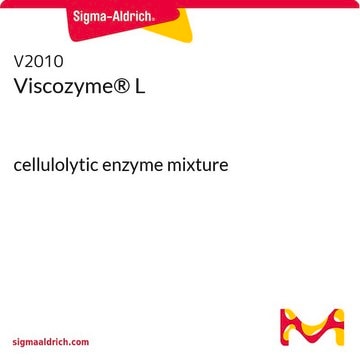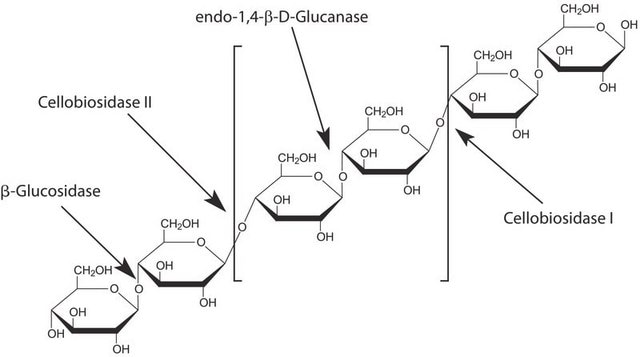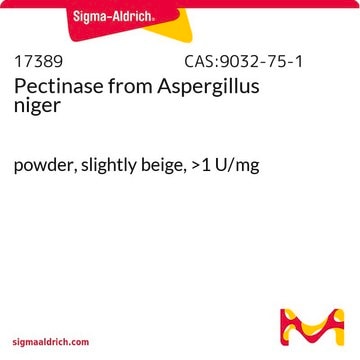The product is offered on the basis of activity. The purity has not been determined.
Wichtige Dokumente
C1184
Cellulase aus Aspergillus niger
powder, ≥0.3 units/mg solid
Synonym(e):
1,4-(1,3:1,4)-β-D-Glucan-4-glucanohydrolase
Größe auswählen
Größe auswählen
About This Item
Empfohlene Produkte
Form
powder
Qualitätsniveau
Spezifische Aktivität
≥0.3 units/mg solid
Grünere Alternativprodukt-Eigenschaften
Design for Energy Efficiency
Learn more about the Principles of Green Chemistry.
sustainability
Greener Alternative Product
Grünere Alternativprodukt-Kategorie
, Enabling
Lagertemp.
2-8°C
Suchen Sie nach ähnlichen Produkten? Aufrufen Leitfaden zum Produktvergleich
Allgemeine Beschreibung
Cellulase belongs to the family of glycoside hydrolase,[1] which is secreted by various cellulolytic microorganisms.[2]
Anwendung
Biochem./physiol. Wirkung
Einheitendefinition
Sonstige Hinweise
Substrat
Signalwort
Danger
H-Sätze
Gefahreneinstufungen
Resp. Sens. 1
Lagerklassenschlüssel
11 - Combustible Solids
WGK
WGK 1
Flammpunkt (°F)
Not applicable
Flammpunkt (°C)
Not applicable
Persönliche Schutzausrüstung
dust mask type N95 (US), Eyeshields, Faceshields, Gloves
Hier finden Sie alle aktuellen Versionen:
Analysenzertifikate (COA)
Die passende Version wird nicht angezeigt?
Wenn Sie eine bestimmte Version benötigen, können Sie anhand der Lot- oder Chargennummer nach einem spezifischen Zertifikat suchen.
Besitzen Sie dieses Produkt bereits?
In der Dokumentenbibliothek finden Sie die Dokumentation zu den Produkten, die Sie kürzlich erworben haben.
Kunden haben sich ebenfalls angesehen
Protokolle
To standardize an enzymatic assay procedure of cellulase.
-
Can you please provide the percent purity of the product?
1 answer-
Helpful?
-
-
Does product C1184 have hemicellulase activity, such as xylanase? I am looking for cellulase without hemicellulase activity.
1 answer-
Hemicellulase activity of this product has not been tested.
Helpful?
-
-
What is the solution stability of Cellulase, Product C1184?
1 answer-
Sigma-Aldrich has not determined the solution stability for this product. However, it is reported in Methods in Enzymology, 160, 264 (1988) that cellulase from Aspergillus niger is "completely stable over the range of pH 5.0-8.0 at 4°C for 24 hours and retains about 50% of its original activity after heating at 70°C for 10 minutes. The enzyme is completely inactivated by heating at 80°C for 10 minutes".
Helpful?
-
-
What is the molecular weight of Product C1184, Cellulase from Aspergillus niger?
1 answer-
The molecular weight is 26,000 Daltons.
Helpful?
-
-
What is the Department of Transportation shipping information for this product?
1 answer-
Transportation information can be found in Section 14 of the product's (M)SDS.To access the shipping information for this material, use the link on the product detail page for the product.
Helpful?
-
-
Are there any additives to Cellulase, Product C1184, in addition to the enzyme itself?
1 answer-
Per information from our supplier, maltodextrin is an extender in this product. Maltodextrin can vary in glucose chain lengths of 2-12. There can also be some free glucose in the product. Either sorbitol or propylene glycol is added to the product as a stabilizer during processing. These components may be "flashed off" during processing, but some small amount may still be present.
Helpful?
-
Active Filters
Unser Team von Wissenschaftlern verfügt über Erfahrung in allen Forschungsbereichen einschließlich Life Science, Materialwissenschaften, chemischer Synthese, Chromatographie, Analytik und vielen mehr..
Setzen Sie sich mit dem technischen Dienst in Verbindung.








